
Giovanni Battista Spinelli (c.1597, Chieti - 20 November 1647 (?), Ortona) was an Italian painter.

Giovanni Battista Spinelli (c.1597, Chieti - 20 November 1647 (?), Ortona) was an Italian painter.
He was born to a wealthy family. His father, Sante, was originally from Bergamo and had moved to Chieti to be a grain merchant. His sister, Caterina, was married to Baron Ludovico de Pizzis of Ortona; known for his numerous feuds. His earliest art lessons may have come from Domenico Carpinoni in the 1620s. [1]
Spinelli established himself throughout Abruzzo, At the Chiesa della Santissima Trinità there is a Coronation of Mary, done around 1630. He also painted at churches in Chieti and Penne.
After 1630, he moved to Naples, where he worked with Massimo Stanzione and Battistello Caracciolo. He is believed to have been the latter's last student. Both of them had a great influence on his compositional style. His is also known to have been an avid collector of prints from Northern Europe; including Lucas van Leyden, Hendrik Goltzius, Jacob Matham and Heinrich Aldegrever. [1] Their influence is often obvious, especially in his mythological and historical portraits.
In recent years, his works have been studied by many art historians, including Roberto Longhi, and his reputation has been somewhat rehabilitated. He has been especially praised for the physical and physiognomic characteristics of his figures. Many of his works can be found at Castellammare di Stabia and in private collections in Naples. Other works are at the Uffizi gallery and an "Adoration of the Shepherds" is in the collection of the National Gallery in London. His individual canvases are difficult to date and of uneven quality; having been painted to the specifications of private clients.
According to his biographer, Bernardo De Dominici, Spinelli gave up painting for alchemy and died while conducting an experiment in 1647, at the approximate age of fifty. [1] More recent studies suggest that he lived until at least 1658.
| Wikimedia Commons has media related to Giovanni Battista Spinelli . |

Nicolas Poussin was the leading painter of the classical French Baroque style, although he spent most of his working life in Rome. Most of his works were on religious and mythological subjects painted for a small group of Italian and French collectors. He returned to Paris for a brief period to serve as First Painter to the King under Louis XIII and Cardinal Richelieu, but soon returned to Rome and resumed his more traditional themes. In his later years he gave growing prominence to the landscape in his paintings. His work is characterized by clarity, logic, and order, and favors line over color. Until the 20th century he remained a major inspiration for such classically-oriented artists as Jacques-Louis David, Jean-Auguste-Dominique Ingres and Paul Cézanne.

Luca Giordano was an Italian late-Baroque painter and printmaker in etching. Fluent and decorative, he worked successfully in Naples and Rome, Florence, and Venice, before spending a decade in Spain.

Guido Reni was an Italian painter of the Baroque period, although his works showed a classical manner, similar to Simon Vouet, Nicolas Poussin, and Philippe de Champaigne. He painted primarily religious works, but also mythological and allegorical subjects. Active in Rome, Naples, and his native Bologna, he became the dominant figure in the Bolognese School that emerged under the influence of the Carracci.

Salvator Rosa is best known today as an Italian Baroque painter, whose romanticized landscapes and history paintings, often set in dark and untamed nature, exerted considerable influence from the 17th century into the early 19th century. In his lifetime he was among the most famous painters, known for his flamboyant personality, and regarded as an accomplished poet, satirist, actor, musician, and printmaker, as well. He was active in Naples, Rome, and Florence, where on occasion he was compelled to move between cities, as his caustic satire earned him enemies in the artistic and intellectual circles of the day.
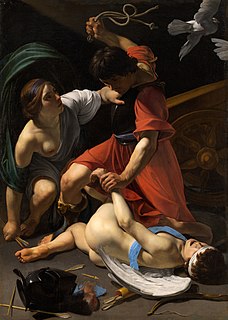
The Caravaggisti were stylistic followers of the late 16th-century Italian Baroque painter Caravaggio. His influence on the new Baroque style that eventually emerged from Mannerism was profound. Caravaggio never established a workshop as most other painters did, and thus had no school to spread his techniques. Nor did he ever set out his underlying philosophical approach to art, the psychological realism which can only be deduced from his surviving work. But it can be seen directly or indirectly in the work of Rubens, Jusepe de Ribera, Bernini, and Rembrandt. Famous while he lived, Caravaggio himself was forgotten almost immediately after his death. Many of his paintings were reascribed to his followers, such as The Taking of Christ, which was attributed to the Dutch painter Gerrit van Honthorst until 1990. It was only in the 20th century that his importance to the development of Western art was rediscovered. In the 1920s Roberto Longhi once more placed him in the European tradition: "Ribera, Vermeer, La Tour and Rembrandt could never have existed without him. And the art of Delacroix, Courbet and Manet would have been utterly different". The influential Bernard Berenson stated: "With the exception of Michelangelo, no other Italian painter exercised so great an influence."

Jusepe de Ribera was a Spanish Tenebrist painter and printmaker, also known as José de Ribera and Josep de Ribera. He also was called Lo Spagnoletto by his contemporaries and early writers. Ribera was a leading painter of the Spanish school, although his mature work was all done in Italy.

Bernardo Strozzi, named il Cappuccino and il Prete Genovese was an Italian Baroque painter and engraver. A canvas and fresco artist, his wide subject range included history, allegorical, genre and portrait paintings as well as still lifes. Born and initially mainly active in Genoa, he worked in Venice in the latter part of his career. His work exercised considerable influence on artistic developments in both cities. He is considered a principal founder of the Venetian Baroque style. His powerful art stands out by its rich and glowing colour and broad, energetic brushstrokes.
Giovanni Benedetto Castiglione was an Italian Baroque painter, printmaker and draftsman, of the Genoese school. He is best known now for his etchings, and as the inventor of the printmaking technique of monotyping. He was known as Il Grechetto in Italy and in France as Le Benédette.

The Denial of Saint Peter(La Negazione di Pietro) is a painting finished around 1610 by the Italian painter Caravaggio. It depicts Peter denying Jesus after Jesus was arrested. The painting is housed in the Metropolitan Museum of Art in New York City.

Giovanni Battista Caracciolo (1578–1635) was an Italian artist and important Neapolitan follower of Caravaggio. He was a member of the murderous Cabal of Naples, with Belisario Corenzio and Giambattista Caracciolo, who were rumoured to have poisoned and disappeared their competition for painting contracts.
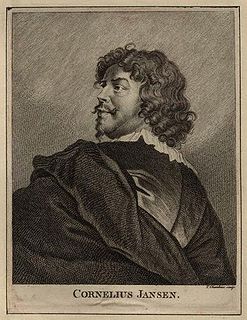
Cornelius Johnson or Cornelis Janssens van Ceulen was an English painter of portraits of Dutch or Flemish parentage. He was active in England, from at least 1618 to 1643, when he moved to Middelburg in the Netherlands to escape the English Civil War. Between 1646 and 1652 he lived in Amsterdam, before settling in Utrecht, where he died.
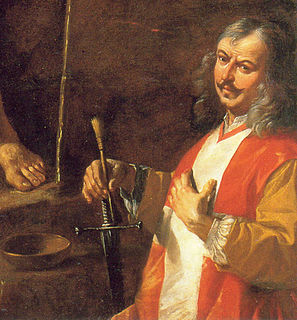
Mattia Preti was an Italian Baroque artist who worked in Italy and Malta. He was appointed a Member of the Order of Saint John.
Gaspar Roomer was a prominent Flemish merchant, banker, art patron and art collector who was active in Naples in the 17th century.

Massimo Stanzione was an Italian Baroque painter, mainly active in Naples, where he and his rival Jusepe de Ribera dominated the painting scene for several decades. Most of his work, in both oils and fresco, depicted religious subjects. A papal knight, he is often referred to as Cavalliere Massimo Stanzione, especially in older sources.

Andrea Vaccaro was an Italian painter of the Baroque period. Vaccaro was in his time one of the most successful painters in Naples, a city then under Spanish rule. Very successful and valued in his lifetime, Vaccaro and his workshop produced many religious works for local patrons as well as for export to Spanish religious orders and noble patrons. He was initially influenced by Caravaggio, in particular in his chiaroscuro and the naturalistic rendering of his figures.
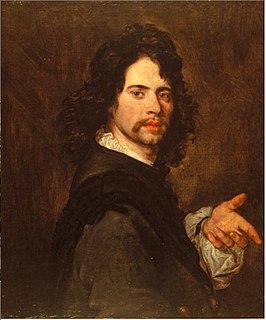
Jan van den Hoecke was a Flemish painter, draughtsman and designer of wall tapestries. He was one of the principal assistants in Rubens' studio in the 1630s. He later traveled to Italy where he resided for a decade in Rome. He subsequently worked as a court painter in Vienna and Brussels. Jan van den Hoecke was a versatile artist who created portraits as well as history and allegorical paintings.
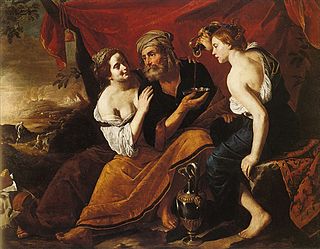
Hendrick de Somer, often erroneously referred to as Hendrick van Someren or Hendrick van Somer, known in Italy as Enrico Fiammingo and Henrico il Fiamingo was a Flemish painter who spent most of his life and career in Italy where he was mainly active in Naples. He was known for his religious and mythological compositions and occasional genre painting. His style was initially influenced by the Spanish painter Jusepe de Ribera who worked in Naples and was a follower of Caravaggio. Later the painter became influenced by the neo-Venetian and Bolognese schools. He is considered one of the leading Netherlandish painters working in Naples in the first half of the 17th century.

Charles Mellin was a French painter of the Baroque era. He was from Nancy, Lorraine, but spent his artistic career in Italy, where he was nicknamed Carlo Lorenese.

Basilio Cascella was an Italian artist, active from the late nineteenth century to the mid-twentieth century.

Bathsheba is a painting by the Baroque painter Artemisia Gentileschi, with contributions by Viviano Codazzi and Domenico Gargiulo. It shows the Hittite woman Bathsheba being washed and tended to by her servants. At the top left of the painting, King David sees her from his palace. It was one of seven versions from the story of Bathsheba that Gentileschi painted.